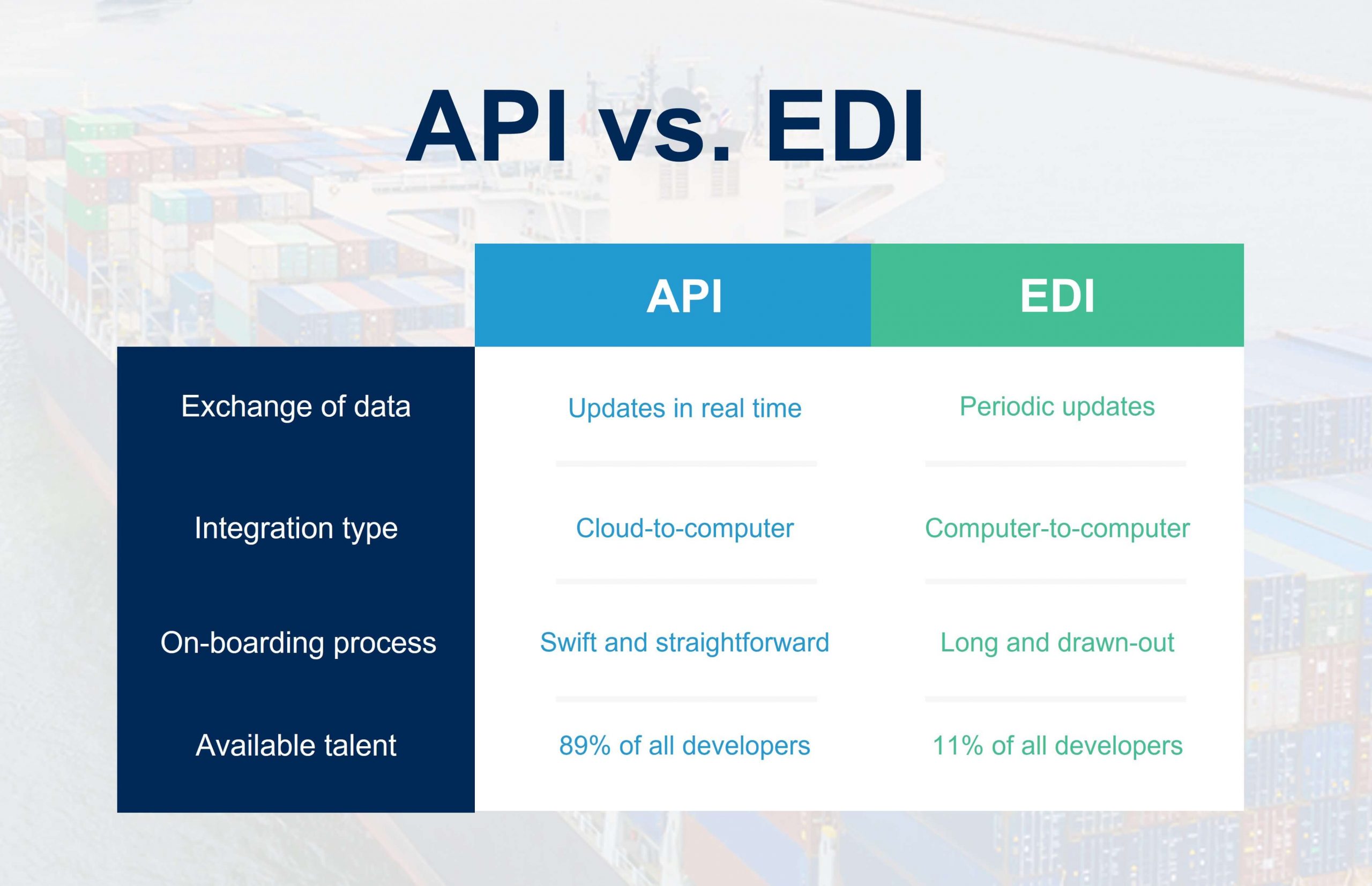
With global port congestion now expected to persist into the early months of 2023, finding ways to increase the management efficiency of ocean freight is becoming of increasing importance.
Previously, I’ve discussed how adjacent technologies – like IoT and geofencing – can upscale the quality and quantity of data that ports can collect on freight to support better decision making when mitigating ocean traffic. Right now, though, a serious barrier to relieving congestion lies in our reliance on legacy systems for the transfer and management of data.
Today, an estimated 85% of logistical data networks rely on Electronic Data Interchanges (EDIs). Defined as “the transfer of structured data, by agreed message standards, from one computer system to another without human intervention,” EDIs were developed by the transportation industry in the 1960s, long before the advent of the internet at a time when computers were just starting to talk to one another and exchange data. They quickly impacted visibility across supply chains, reducing human interaction to improve inventory management, lower costs and enable more accurate accounting.
Challenges arise because EDIs work by storing then exchanging data. While this mode of operation helps ensure a secure data exchange, it requires specific transmission and therefore prevents real-time data transfer and analysis. This can not only have the effect of delaying decision making, it can also in turn trigger a misdistribution of resources, further contributing to overcrowding at global ports. We need to let go of some legacy systems or attempts to make progress will be in vain.
Enter the API, globally established for data exchange and service innovation
A much larger proverbial jar takes the form of standards-based Application Programming Interfaces (APIs) for collecting and transferring data. APIs are software intermediaries which allow multiple applications to share data and communicate, automatically, in real-time. In the context of shipping and logistics, APIs enable the improvement of management software by aggregating data from multiple pre-existing sources. More data means more information for superior decision making when it comes to moving cargo between nodes in ports and holds massive potential for a wide variety of innovative applications to serve freight forwarders, carriers, and shipping agencies.
APIs are already improving consumer experiences across the board. In 2020 for example, the EU Joint Research Centre (JRC), published a paper outlining how APIs are improving state governance within its member states. By enabling access to government data, facilitating smarter interactions across government bodies and with the private sector (B2G), and supporting the integration of leading-edge SaaS, the JRC demonstrated how APIs are pushing innovation and governmental capacity when these things are in high demand.
But the fact that APIs are recognizably important to the world’s largest trading bloc barely scratches the surface of how versatile they have been in the wider macroeconomy. Today, APIs are fundamental for wide-reaching life science innovations in the data-driven, New Health era: they’ve made e-tickets and self-service standard practice for air travel; even challenger banks like Monzo and Starling owe their disruptiveness to digital real-time exchange using APIs.

API Supply Chain
Data, Data, Data
For the shipping and logistics industries, the most important takeaway is that standards-based APIs can facilitate real-time data exchange, vastly improving the provision of services. Since EDIs only send periodic updates between partners, using standards which also vary hugely from company to company, the margin of error for mismanaging ships between docks, terminals, and berths is actually much higher where EDI systems are in place.
By contrast, APIs enable interoperability: the collection and integration of data from various streams in real time. In practice, this means that sources like GPS data – causing, in 90% of polled companies within the field service industry, an increase in work order completion – can be cross-referenced with data on arrival predictions, container tracking, and vessel schedules in real time. What’s more, these can be combined with historic data for machine learning (ML), providing even more intelligent data for decision making in the process.
There are also benefits to be gained with predictability and decision making. As APIs enable partners to access collected and analyzed information, stakeholders within the supply chain are alerted to potential disruptions, which empowers them to respond accordingly. It is no wonder, then, that nine of the ten largest cargo carriers in the world, representing around 70% of the global shipping market, are members of the Digital Container Shipping Association (DCSA). A not-for-profit, the DCSA uses its membership to support the development of the DCSA API, which features standards for improved cyber security, bills of lading, IoT and track and trace within the cargo industry.
Another great advantage of using APIs within ocean freight is that onboarding partners is a swift, straightforward process, which is a refreshing change of pace from the long, drawn-out process of onboarding when compared to EDIs. Onboarding companies with shipping EDIs, for example, can take anywhere from 4-6 weeks – far longer compared to API onboarding, which only takes one to two days.
Being globally ubiquitous, APIs are supported by a colossal, 19.1 million-strong talent pool, and make up 89% of all developers. 37% of these specialize in the location and mapping services which are vital for port management. Comparatively, EDI developers are few and far between and just 11% of developers are EDI-literate. Talent acquisition for API integration and maintenance is therefore future-proofed for a market is predicted to grow 34% a year until 2027. Not only will this ease the process for realizing systemic change within logistics companies, but it also means that processes can continue to be streamlined internally without the need for a major systemic overhaul in the long term.
Advancing use of APIs in Global Shipments
Freight forwarders are one group of stakeholders already reaping the benefits of service innovations. According to a report from KPMG, customers were overpaying by up to 40% prior to the introduction of digital freight forwarding platforms, as a result of information silos between firms. However, freight forwarders now have the transparency necessary to mitigate information asymmetry, resulting in significant cost savings.
The reality is that today, just 28% of transport and logistics companies see themselves as digitally advanced; in the automotive industry, this rises to 41%, and for electronics companies, this is as high as 45%.
Interfacing with APIs – why now?
With significantly faster onboarding, better available talent, reduced downtime and cost savings, bringing a standards-based API into your applications translates into greater innovation capacity, resulting in better services being provided. Critically, companies can utilize open APIs, like the DCSA API, to analyze the publicly available data lake, enabling the creation of new applications in response to changing customer demands. By having a multi-stakeholder network in one place, these demands can be better understood, resulting in more satisfied participants in your whole value chain.
Written by
Martin Dommerby
Former CEO of GateHouse Maritime


GET IN TOUCH
You have come this far - how about we take it a step further and get you started with us? Complete the form below and we will get in touch as soon as possible. Alternatively, feel free to contact us directly using our contact details listed below.
We so look forward to hear from you!
"*" indicates required fields

